Win10系统VS2019+Cmake+vtk_8.2.0环境配置
1 vtk
1.1 简要介绍
VTK(visualization toolkit)是一个开源的BSD许可证免费软件系统,主要用于三维计算机图形学、图像处理和科学计算可视化。VTK是在三角函数库OpenGL的基础上采用面向对象的设计方法发展起来的,它将我们在可视化开发过程中会经常遇到的细节屏蔽起来,并将一些常用的算法封装起来。
1.2 依赖库
vtk一般不需要再配置其他库。
1.2.1 MPI
非必选,如果想要编译vtkIOMPIImage或vtkIOMPIParallel模块,需要依赖MPI库,用于加速。
MPI库下载地址:
https://www.microsoft.com/en-us/download/details.aspx?id=57467
注:对于编译vtk,下载msmpisdk.msi即可,即MPI库的SDK,安装后生成include和Lib两个文件夹。
1.3 源码包下载
vtk源码地址:
github:https://github.com/Kitware/VTK.git
2 Cmake构建项目
2.1 路径
源代码路径:D:/ThirdParty/vtk/VTK_8.2.0
构建项目路径:D:/ThirdParty/vtk/VTK_8.2.0_build
2.2 构建选项

如果想要编译vtkIOMPIImage或vtkIOMPIParallel这两个模块,还需要如下设置:

注:这样的配置仅能保证Configure能过,Generate代码时会有一堆报警,但也能成功生成项目,但这在编译vtkParallelMPI,vtkIOMPIImage和vtkIOParallelNetCDF这3个项目时,仍会报MPI中无法解析的外部符号错误,我是针对这3个项目,在附加依赖项中,手动添加了MPI库Lib/x64文件夹下的几个库文件名,我对cmake不熟,没有找到更好的办法,大家要是有更好的方法,欢迎留言赐教。
另外,针对这3个项目,在附加库目录中,手动添加了MPI库Include/x64文件夹的路径。
2.3 构建项目
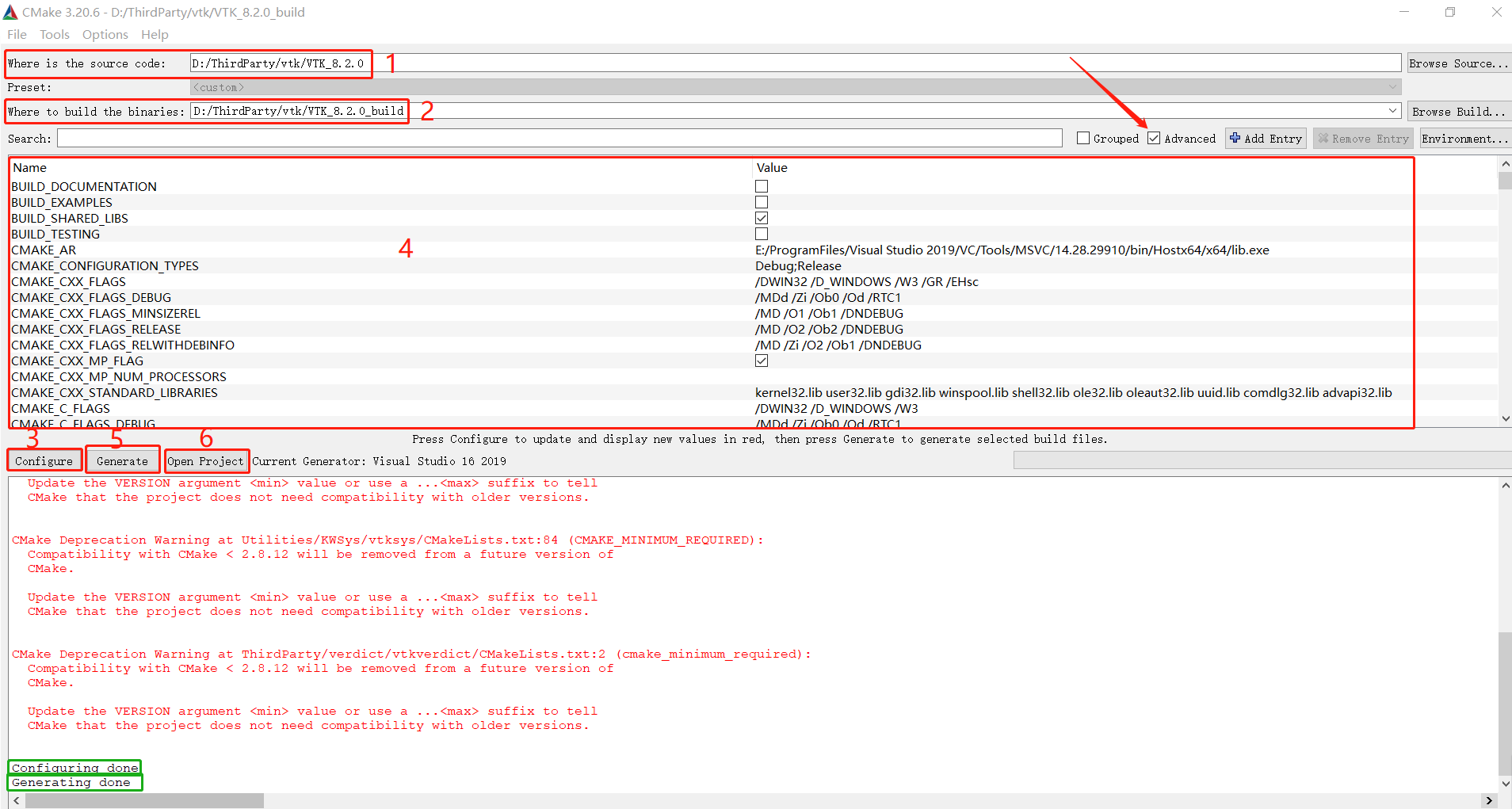
步骤如下:
- 指定源码路径;
- 指定构建项目路径;
- 点击Configure;
- 按照2.2节表中的值进行设置;
- 再次点击Configure;
- 点击Generate,构建项目路径中将生成解决方案文件VTK.sln。
- 点击Configure或Generate后,如果顺利,会出现Configuring done
点击Configure或Generate后,如果顺利,会出现Configuring done或Generating done。
3 打开解决方案并编译
3.1 编译解决方案
点击Open Project(或者在2.3节步骤2中指定的构建项目路径中,找到生成的解决方案文件VTK.sln,通过Visual Studio打开),打开通过Cmake构建的项目;
选中ALL_BUILD项目,分别在Debug和Release模式下,重新生成解决方案。

3.2 安装vtk
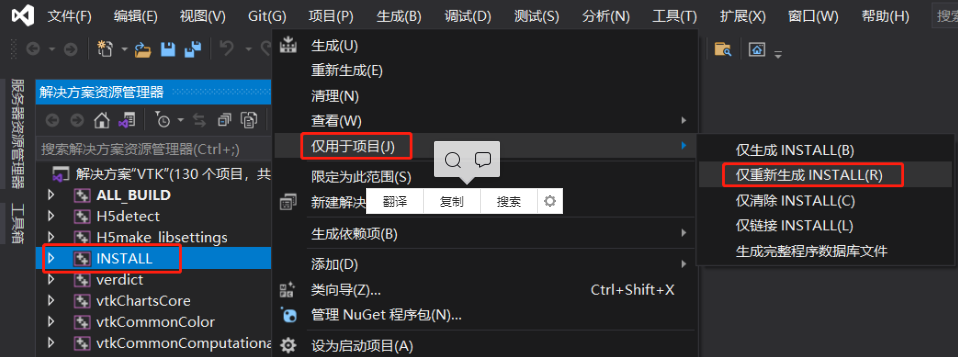
选中INSTALL项目,右击,重新生成,此时,将会在指定路径下(2.2节表中CMAKE_INSTALL_PREFIX选项的值)主要生成3个文件夹include和lib和bin。
4 实际项目环境配置
注:以下通过属性表的方式进行环境配置。
4.1 附加包含目录
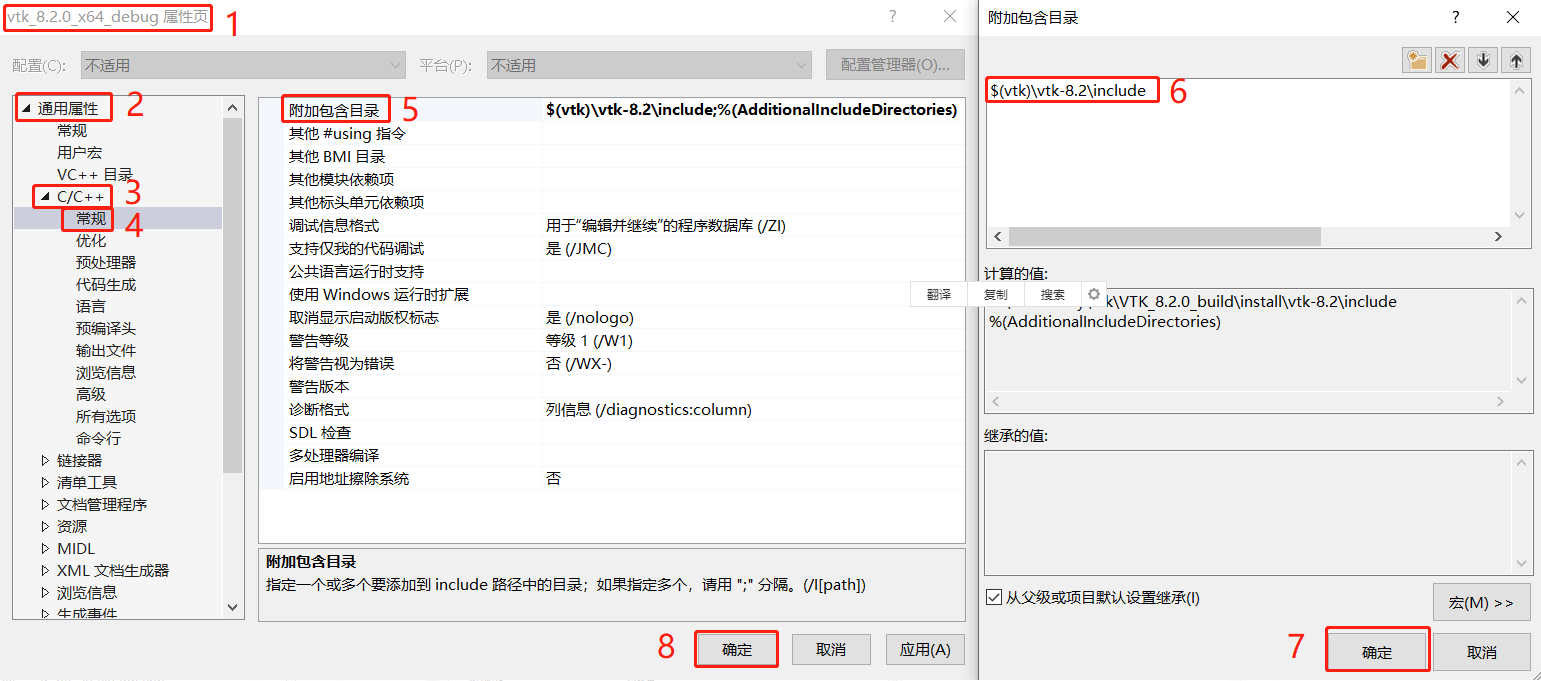
$(vtk)\vtk-8.2\include
$(vtk)(在系统环境变量中添加并设置)就是2.2节表中CMAKE_INSTALL_PREFIX选项的值。
4.2 附加库目录
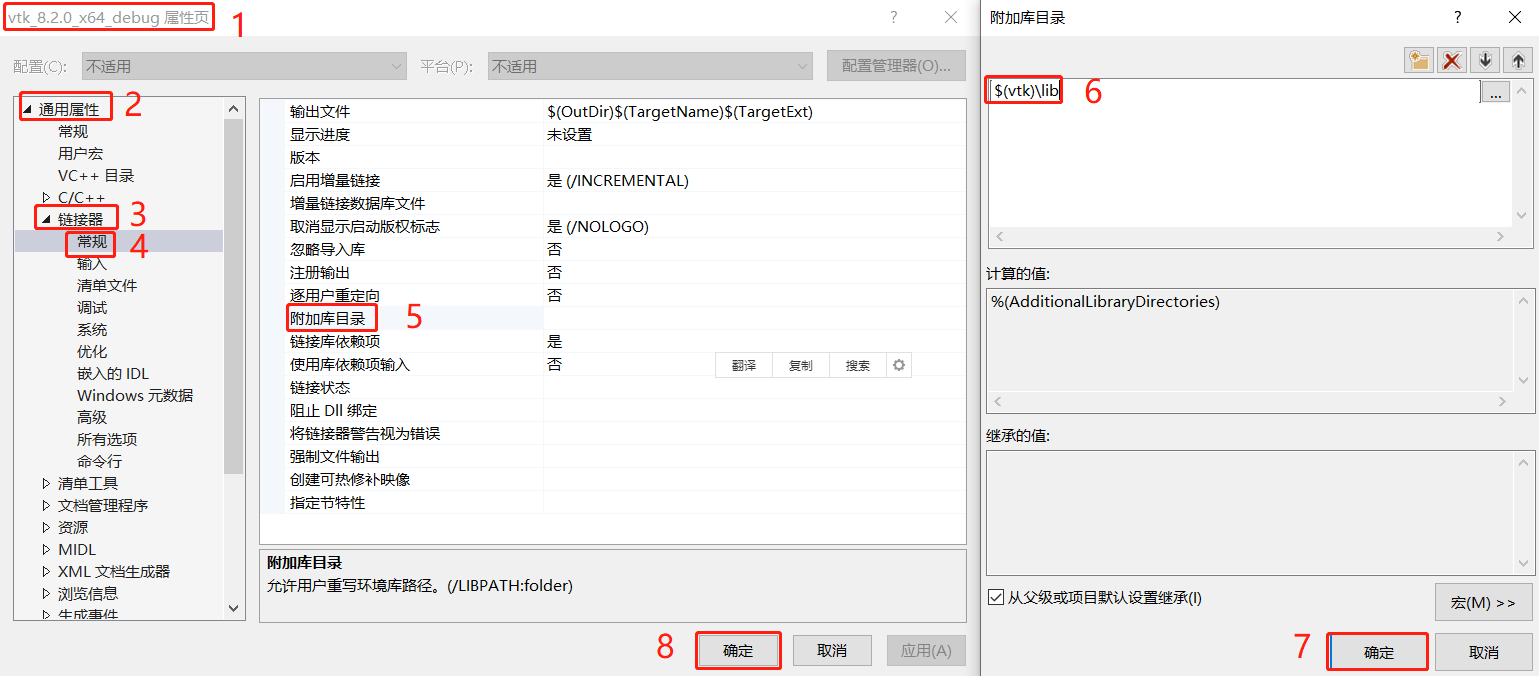
$(vtk)\lib
4.3 附加依赖项
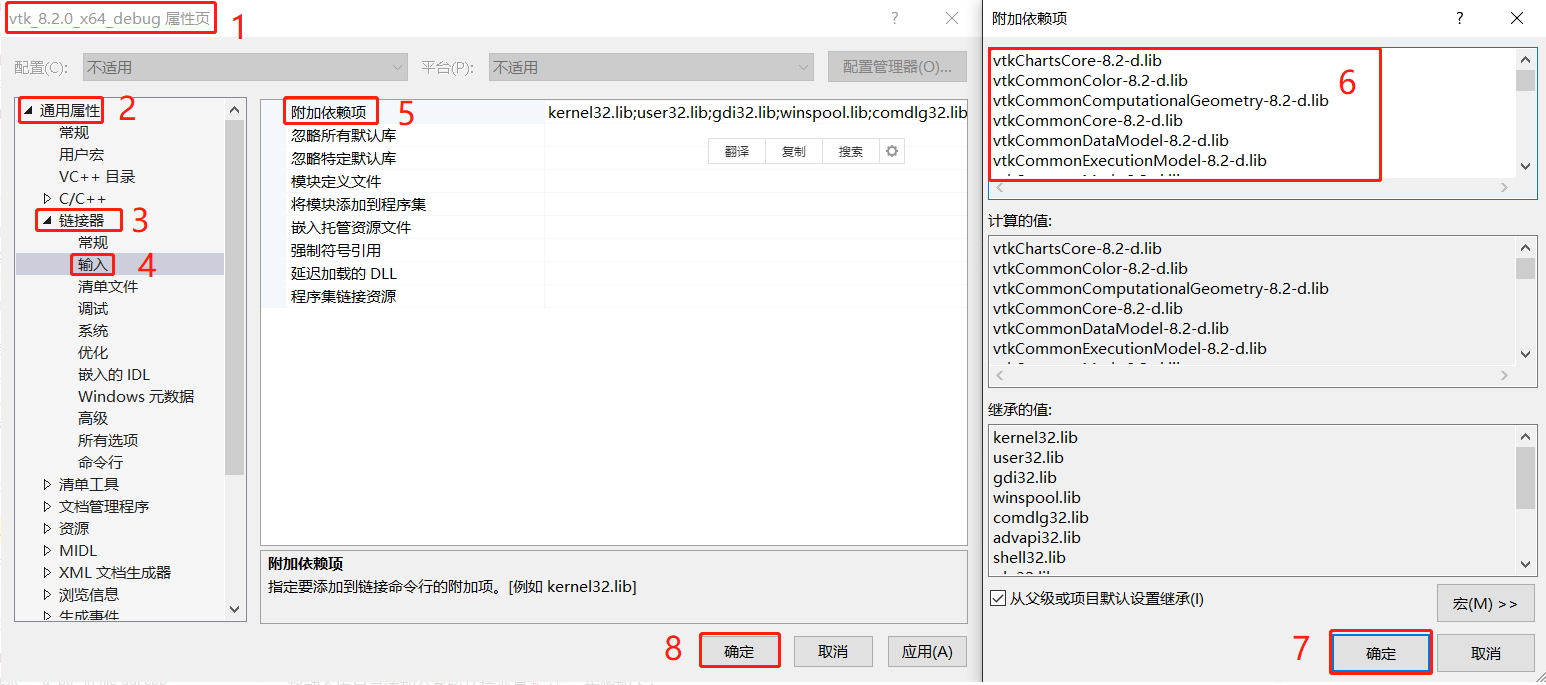
将库目录$(vtk)\lib中文件后缀名为.lib的文件依次添加至附加依赖项中,并依次配置debug版本(文件名中有d)和release版本。
注意,添加附加依赖项时,不要漏掉文件后缀名.lib!
4.4 动态库
将动态库目录添加至系统环境变量Path,步骤如下:
- 计算机右击,点击“属性”;
- 点击“高级系统设置”;
- 点击“环境变量”;
- 双击
Path; - 添加
%vtk%\bin,该目录下是包含了动态库文件。

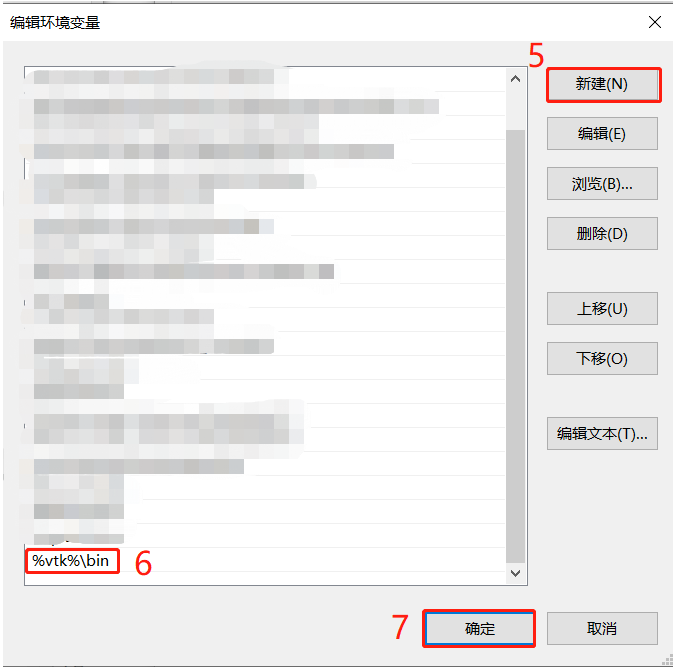
本文使用的都是相对路径,因此需事先设置好环境变量vtk,值为CMAKE_INSTALL_PREFIX对应的目录,也可以使用绝对路径。
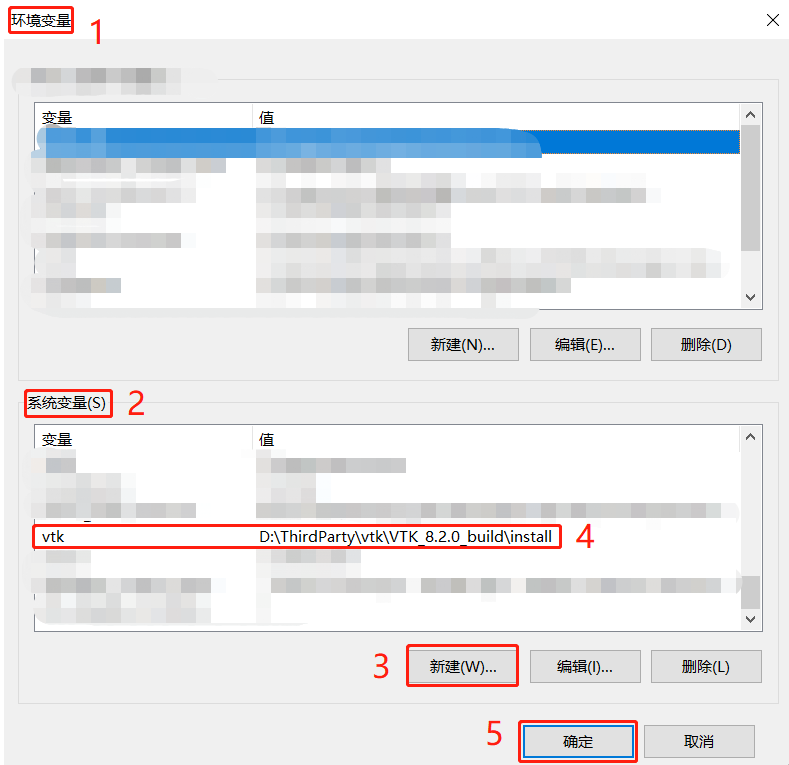
注:上述步骤是按照加载vtk动态库的方式进行配置的; 当然也可以按照静态库的方式配置,可省略步骤4.4。
4.5 测试代码
/*========================================================================= Program: Visualization Toolkit Module: Cone.cxx Copyright (c) Ken Martin, Will Schroeder, Bill Lorensen All rights reserved. See Copyright.txt or http://www.kitware.com/Copyright.htm for details. This software is distributed WITHOUT ANY WARRANTY; without even the implied warranty of MERCHANTABILITY or FITNESS FOR A PARTICULAR PURPOSE. See the above copyright notice for more information. =========================================================================*/ // // This example creates a polygonal model of a cone, and then renders it to // the screen. It will rotate the cone 360 degrees and then exit. The basic // setup of source -> mapper -> actor -> renderer -> renderwindow is // typical of most VTK programs. // // First include the required header files for the VTK classes we are using. #include <vtkAutoInit.h> VTK_MODULE_INIT(vtkRenderingOpenGL2); VTK_MODULE_INIT(vtkInteractionStyle); VTK_MODULE_INIT(vtkRenderingFreeType); //#define vtkRenderingCore_AUTOINIT 2(vtkInteractionStyle,vtkRenderingOpenGL2) #include "vtkConeSource.h" #include "vtkPolyDataMapper.h" #include "vtkRenderWindow.h" #include "vtkCamera.h" #include "vtkActor.h" #include "vtkRenderer.h" int main() { // // Next we create an instance of vtkConeSource and set some of its // properties. The instance of vtkConeSource "cone" is part of a // visualization pipeline (it is a source process object); it produces data // (output type is vtkPolyData) which other filters may process. // vtkConeSource* cone = vtkConeSource::New(); cone->SetHeight(3.0); cone->SetRadius(1.0); cone->SetResolution(10); // // In this example we terminate the pipeline with a mapper process object. // (Intermediate filters such as vtkShrinkPolyData could be inserted in // between the source and the mapper.) We create an instance of // vtkPolyDataMapper to map the polygonal data into graphics primitives. We // connect the output of the cone source to the input of this mapper. // vtkPolyDataMapper* coneMapper = vtkPolyDataMapper::New(); coneMapper->SetInputConnection(cone->GetOutputPort()); // // Create an actor to represent the cone. The actor orchestrates rendering // of the mapper's graphics primitives. An actor also refers to properties // via a vtkProperty instance, and includes an internal transformation // matrix. We set this actor's mapper to be coneMapper which we created // above. // vtkActor* coneActor = vtkActor::New(); coneActor->SetMapper(coneMapper); // // Create the Renderer and assign actors to it. A renderer is like a // viewport. It is part or all of a window on the screen and it is // responsible for drawing the actors it has. We also set the background // color here. // vtkRenderer* ren1 = vtkRenderer::New(); ren1->AddActor(coneActor); ren1->SetBackground(0.1, 0.2, 0.4); // // Finally we create the render window which will show up on the screen. // We put our renderer into the render window using AddRenderer. We also // set the size to be 300 pixels by 300. // vtkRenderWindow* renWin = vtkRenderWindow::New(); renWin->AddRenderer(ren1); renWin->SetSize(300, 300); // // Now we loop over 360 degrees and render the cone each time. // int i; for (i = 0; i < 360; ++i) { // render the image renWin->Render(); // rotate the active camera by one degree ren1->GetActiveCamera()->Azimuth(1); } // // Free up any objects we created. All instances in VTK are deleted by // using the Delete() method. // cone->Delete(); coneMapper->Delete(); coneActor->Delete(); ren1->Delete(); renWin->Delete(); std::system("pause"); return 0; }
如果编译时报错,提示error LNK2019:无法解析的外部符号 __imp_SymGetLineFromAddr64,解决方案如下:
“项目”–>“属性”–>“链接器”–>“输入”–>“附加依赖项”,添加dgbhelp.lib。
如果运行时报错,提示Error: no override found for 'vtkPolyDataMapper',解决方案如下:
- 在附加依赖项中添加
opengl32.lib; - 程序开头添加如下代码:
#include <vtkAutoInit.h> VTK_MODULE_INIT(vtkRenderingOpenGL2); // 也有可能是VTK_MODULE_INIT(vtkRenderingOpenGL); VTK_MODULE_INIT(vtkInteractionStyle); VTK_MODULE_INIT(vtkRenderingFreeType);
或者程序开头直接添加一句代码:#define vtkRenderingCore_AUTOINIT 2(vtkInteractionStyle,vtkRenderingOpenGL2)。
这句代码来源于编译代码生成目录D:\ThirdParty\vtk\VTK_8.2.0_build\CMakeFiles下的vtkRenderingCore_AUTOINIT_vtkInteractionStyle_vtkRenderingOpenGL2.h文件内。







【推荐】国内首个AI IDE,深度理解中文开发场景,立即下载体验Trae
【推荐】编程新体验,更懂你的AI,立即体验豆包MarsCode编程助手
【推荐】抖音旗下AI助手豆包,你的智能百科全书,全免费不限次数
【推荐】轻量又高性能的 SSH 工具 IShell:AI 加持,快人一步
· 阿里最新开源QwQ-32B,效果媲美deepseek-r1满血版,部署成本又又又降低了!
· 开源Multi-agent AI智能体框架aevatar.ai,欢迎大家贡献代码
· Manus重磅发布:全球首款通用AI代理技术深度解析与实战指南
· 被坑几百块钱后,我竟然真的恢复了删除的微信聊天记录!
· 没有Manus邀请码?试试免邀请码的MGX或者开源的OpenManus吧